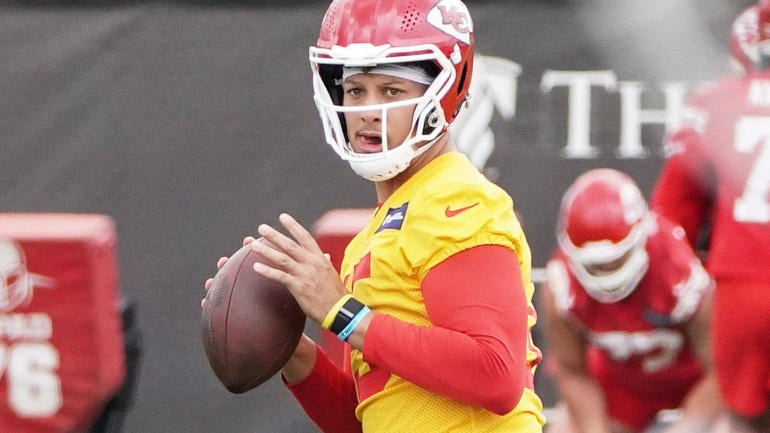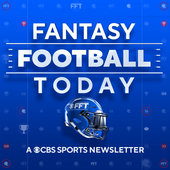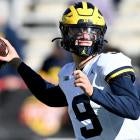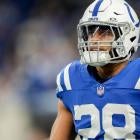
Last year, only four quarterbacks averaged over 24 points per game (six-point-passing-TD leagues). Two years ago that number was 12.
The flipside is that nine other passers averaged between 20 and 22 points per game, many of which underwhelmed on their way to that mark. For instance, Justin Fields started slow (10.4 points per game in his first four) before catching fire (26.2 from Week 5 on) while Lamar Jackson began the season flying high (40.7 in his first three) before getting grounded (16.4 in his last nine).
Two things happened here: One, the position remained satisfactorily deep given that 13 passers at least made it to 20 points per game. Two, other positions weren't deep with mega-studs. Only 14 wide receivers averaged more than 15 PPR points per game last year ... and 17 receivers scored between 12 and 14.9 points per game. Same thing at running back: Ten rushers averaged 15-plus, 14 more averaged between 12 and 14.9. You know tight ends weren't great once you got past the top guy or three.
What's a manager to do? Simple: if you're not going to get a stat dominator at another position, the natural pivot is to take a stat dominator at quarterback. And because there are fewer stat dominators expected at the other positions, the consensus will chase a stat-dominating quarterback sooner.
It's supply and demand. And truthfully, it's been going on in home leagues for years. This year, it feels justified.
The Tier 1 quarterbacks all have potential for as many as 30 Fantasy points per game (25 points in four-point passing touchdown formats). They'll all be long gone by the end of Round 2 in one-QB leagues, so if you happen to find yourself in Round 2 and you don't love anyone left at the other positions, do not hesitate to take one of these three. Don't get upset if others take them in Round 1 -- they're costing themselves value at other positions.
You will feel much better about your bargain power, however, if you pick from Tier 2. These five quarterbacks are capable of turning in 25 or more points per game (21 or more in four-point passing touchdown formats). You should be able to wait as many as three rounds later than Tier 1 and collect someone with close to the upside as the QBs taken before 24th overall.
Both of the quarterbacks in Tier 3 have great upside, but they have flaws you have to account for -- Tua Tagovailoa with his recent injury history, Anthony Richardson with his inaccuracy and inexperience. You'll feel better rostering them if you have another quarterback behind them in case they stink or get hurt.
Tier 4 is fine if you're satisfied with 20 to 23 Fantasy points per game from your signal-caller. These are also the same quarterbacks you'll target if you want a really good backup to pair with a high-ceiling/low-floor starter.
Tier 5 quarterbacks have similar upside to Tier 4 but more downside. Do not expect all of these quarterbacks to get taken in your one-QB drafts, meaning that some could be valuable waiver-adds during the year.

Fantasy Football Today Newsletter
Know What Your Friends Don't
Get tips, advice and news to win your league - all from the FFT podcast team.
Thanks for signing up!
Keep an eye on your inbox.
Sorry!
There was an error processing your subscription.
DAVE'S FAVORITE STRATEGY IF YOU START ONE QB: Aim for one of the quarterbacks in the first two tiers, but don't take one if it means passing on a very good player at another position. Tier 3 is the fallback plan, which means you will end up taking two quarterbacks. If you wait until Tier 4 to find a quarterback, you better have a stacked roster otherwise.
DAVE'S FAVORITE STRATEGY IN SUPERFLEX/TWO-QB FORMATS: The entire equation changes because the demand changes. Don't hesitate to spend two of your first three picks on quarterbacks, especially if you can pick up one from Tiers 1 and 2.
Quarterback tiers (updated 8/4)
P. Mahomes
KC
Patrick Mahomes
KC
|
J. Hurts
PHI
Jalen Hurts
PHI
|
J. Allen
BUF
Josh Allen
BUF
|
J. Burrow
CIN
Joe Burrow
CIN
|
J. Fields
PIT
Justin Fields
PIT
|
L. Jackson
BAL
Lamar Jackson
BAL
|
J. Herbert
LAC
Justin Herbert
LAC
|
T. Lawrence
JAC
Trevor Lawrence
JAC
|
T. Tagovailoa
MIA
Tua Tagovailoa
MIA
|
A. Richardson
IND
Anthony Richardson
IND
|
D. Prescott
DAL
Dak Prescott
DAL
|
D. Watson
CLE
Deshaun Watson
CLE
|
K. Cousins
ATL
Kirk Cousins
ATL
|
G. Smith
SEA
Geno Smith
SEA
|
A. Rodgers
NYJ
Aaron Rodgers
NYJ
|
D. Jones
NYG
Daniel Jones
NYG
|
J. Goff
DET
Jared Goff
DET
|
R. Wilson
PIT
Russell Wilson
PIT
|
M. Stafford
LAR
Matthew Stafford
LAR
|
B. Young
CAR
Bryce Young
CAR
|
K. Murray
ARI
Kyler Murray
ARI
|
D. Carr
NO
Derek Carr
NO
|
B. Purdy
SF
Brock Purdy
SF
|
J. Love
GB
Jordan Love
GB
|
K. Pickett
PHI
Kenny Pickett
PHI
|
C. Stroud
HOU
C.J. Stroud
HOU
|
R. Tannehill
TEN
Ryan Tannehill
TEN
|
D. Ridder
ARI
Desmond Ridder
ARI
|
J. Garoppolo
LAR
Jimmy Garoppolo
LAR
|
S. Howell
SEA
Sam Howell
SEA
|
Which sleepers, breakouts and busts should you target and fade, and which QB shocks the NFL with a top-10 performance? Visit SportsLine now to get cheat sheets for every single position, all from the model that nailed Deebo Samuel as a bust last year, and find out.






















